Hemlock Trees (Tsuga): Canadian, Western, Leaves, Bark (Pictures) – Identification
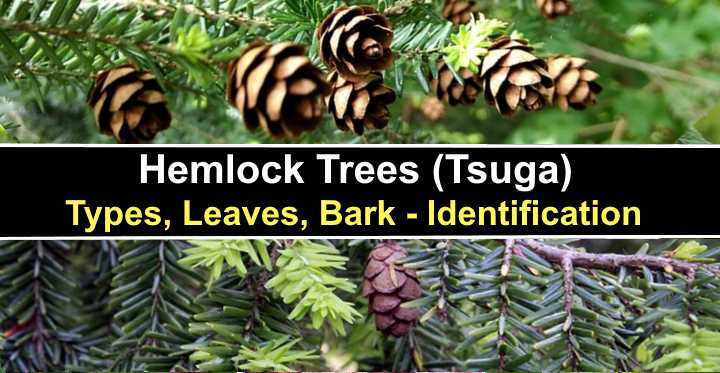
Hemlock trees (botanical name Tsuga) are a species of large evergreen coniferous trees native to North America. Hemlock trees are identified by their conical shape, flat, aromatic needle-like leaves, oval or cylindrical seed-bearing cones, and reddish-brown bark. Cultivars of the popular Eastern hemlock or Canadian hemlock are also beautiful landscaping trees or shrubs that are easy to grow.
Evergreen hemlock trees belong to the pine family Pinaceae. There are four species of hemlock native to North America: Eastern hemlock (Tsuga canadensis), Western hemlock (Tsuga heterophylla), Mountain hemlock (Tsuga mertensiana), and the Carolina hemlock (Tsuga caroliniana). However, the Carolina hemlock species is relatively rare in the wild.
Native hemlock trees generally grow between 30 and 230 ft. (10 – 70 m) tall. The hemlocks have a characteristic irregular conical crown that becomes cylindrical with age.
Hemlocks are cold-hardy evergreens that grow in USDA zones 3 to 7. The tall, conical trees are common in evergreen forests where there is damp soil and cool temperatures. From all the types of conifers, hemlock trees grow best in the shade. However, in northern cold climates, hemlock conifers thrive in full sun.
This article is a complete guide to identifying hemlock trees. Descriptions and pictures of hemlocks will help differentiate these majestic conifers from pine trees, spruce trees, and fir trees.
Hemlock Tree Leaves (Needles)

Hemlock leaves
Hemlock needle leaves are an identifying feature of trees in the genus Tsuga. The evergreen needle-like leaves are recognizable by their flat appearance and blunt, rounded tips. Another characteristic of a hemlock leaf is a smooth, shiny dark green upper side and parallel white stripes on the underside.
Hemlock leaves vary in length on the branch. Typically, the needle leaves are 0.6” to 0.8” (1.5 – 2 cm) long. However, they can be as short as 0.2” (0.5 cm).
Looking closely at pictures of hemlock leaves, you will spot fine serration on the needle margins, especially near the blunt tip. Hemlock leaves are arranged alternately on the reddish-brown twigs, sometimes twisted at the base, so the leaves lie flat. Unlike pine needles that grow in clusters, there is only one leaf per node.
Hemlock Tree Cones

Hemlock cones
Hemlock cones look like small oval, woody cylinders dangling from the branches. All conifers are identified by seed-producing cones. Hemlock cones are recognizable by their ovoid (egg shape) globular form. Cones on hemlock trees measure 0.6” to 1” (1.5 – 2.5 cm) and, like pine cones, hang pendulous from branches.
Hemlock tree cones emerge greenish to reddish-purple. As the season progresses, the cones become woodier and turn brown. You’ll notice that as hemlock cones age, the ovate-shaped woody scales open outward.
Hemlock Tree Bark
A hemlock tree is identifiable by its smooth gray bark that becomes scaly and flakes off to reveal reddish-brown inner bark. As hemlock trees mature, the bark becomes a characteristic dark brown with flat plates divided by thick ridges.
Hemlock vs. Pine

Pine needles (in the picture) are round and grow in clusters, and the cone is larger and more elongated compared to hemlock tree
The main difference between a hemlock tree and a pine tree is their needle-like leaves. Looking at hemlock needles on a branch, you’ll notice they are attached individually by a small peg. In contrast, pine needles grow in bundles with two to five needles per cluster.
Another identifying feature is that hemlock leaves are flat, not round. This fact means hemlock needles won’t roll between your fingers. However, if you take pine or larch tree needles, you will be able to roll them easily between fingers.
Another way to tell hemlocks apart from pine trees is to look at the cones. Hemlock cones are smaller and have larger scales than pine tree cones. Additionally, hemlock tree cones are more rounded or globular than pine cones.
Visually, there are a few identifying differences between pines and hemlocks. Both hemlock and pine trees have a conical shape. But comparing the two genera, hemlocks tend to have a drooping appearance. Pines tend to have horizontal branches or a general upward growth.
Related reading: How to identify pine trees.
Hemlock Tree Identification
Identify hemlock trees by their needle leaves, cones, reddish-brown scaly bark, and drooping growth habit. The identifiable characteristic of hemlocks is their flat, glossy, green needle leaves with white stripes on one side. Also, look for small, egg-shaped cones with large, rounded brown scales hanging off branches.
Types of Hemlock Trees
Let’s look in more detail at the most common species of hemlock trees. You will also find information about suitable hemlock cultivars you can use in garden landscaping.
Canadian Hemlock or Eastern Hemlock (Tsuga canadensis)
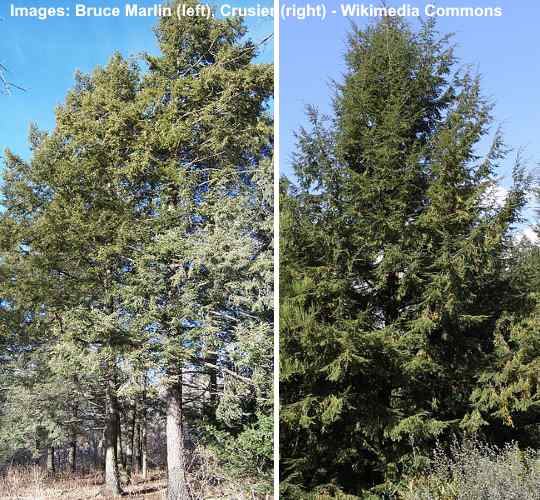
Canadian Hemlock or Eastern Hemlock (Tsuga canadensis) trees
The Eastern hemlock (Tsuga canadensis) is a medium-sized conifer with flat sprays of short, glossy green needles and small egg-shaped cones. Canadian hemlock grows between 40 and 70 ft. (12 – 21 m) tall. Eastern hemlocks are recognized by their broadly conical shape, straight trunk, and branches that droop at the tips.
As its name suggests, Eastern hemlocks grow on the eastern side of North America. You’ll find the majestic evergreen hemlocks in states such as Michigan, Connecticut, Maine, and eastern Canada. The Eastern hemlock is also the state tree of Pennsylvania.
Canadian hemlocks thrive in USDA zones 3 through 7. The tree has a slow to medium growth rate even in ideal growing conditions. Unlike most conifers, the Eastern hemlock thrives in partial to full shade. Evergreen hemlocks also perform well in damp soils and can be found growing in wetlands.
Due to their slow growth, Canadian hemlocks are good evergreen trees for large gardens or shaded backyards. The hemlock’s drooping branches and dense needle-like leafy foliage make this an elegant shade tree. With pruning, you can also grow hemlocks as a privacy screen, tall evergreen hedge, or specimen tree.
Canadian Hemlock Bark

Canadian hemlock bark
Bark on Canadian hemlock trees is a grayish-brown color with a scaly texture that tends to peel. As the tree matures, Eastern hemlock bark develops deep ridges and furrows along with rounded plates. Mature Eastern hemlock trees have red-brown to gray-brown thick, fissured bark.
Canadian Hemlock Cones

Canadian hemlock cones
Canadian hemlock tree cones are ovoid or egg-shaped, measuring up to 1” (2.5 cm) long. The small globular cones appear green when young. As they mature, hemlock cones become woody, and the rounded scales project outward. The pendant hemlock cones grow in abundance and dangle from branches.
Canadian Hemlock Needles

Canadian hemlock needles
Canadian hemlock tree needles are flat shiny green leaves that grow around 0.5” (1.2 cm) long. The needled Canadian hemlock leaves are identified by two white lines on the underside and rounded tips with slightly toothed edges. Small hemlock leaves attach singularly to branches by short stems.
Canadian Hemlock Identification
A Canadian hemlock tree is identified by its flat sprays of dense feathery needles, small ovoid-shaped pendant cones, and reddish-brown scaly bark. In open landscapes, the Eastern hemlock looks like a giant Christmas tree. The hemlock is also recognizable by its broadly conical shape and slightly drooping branches.
Eastern Hemlocks in Garden Landscapes
Canadian hemlocks are easy to grow in a garden or backyard, especially in shade gardens with poor drainage. Dwarf varieties of hemlock trees are easy to prune, keep their shape, and cause little mess. You can grow Eastern hemlocks as foundation plantings, screens, hedge plants, or a specimen shade tree.
To care for Canadian hemlock trees or shrubs, plant them in a sheltered location, protected from the hot afternoon sun. Ideally, the hemlocks grow best in acidic, fertile soil that is kept moist but has excellent drainage. Unless you are growing a formal evergreen hedge, it’s rarely necessary to prune hemlocks.
Canadian Hemlock Varieties
Several varieties of Canadian hemlocks are suitable for growing in your garden landscape. These hemlock cultivars are developed especially for smaller, residential areas where it’s impractical to grow a large, imposing tree.
Weeping Canadian Hemlock (Tsuga canadensis ‘Pendula’)

Weeping Canadian hemlock (Tsuga canadensis ‘Pendula’)
The Eastern hemlock cultivar, Tsuga canadensis ‘Pendula’, is a beautiful weeping evergreen tree with drooping foliage, dark green needles, and tiny woody cones. The Weeping Canadian hemlock grows up to 5 ft. (1.5 m) tall and 10 ft. (3 m) wide. Suitable as an informal hedge, small screen, lawn specimen, or growing beside a pond.
Eastern Hemlock ‘Sherwood Compact’ (Tsuga canadensis ‘Sherwood Compact’)

Tsuga canadensis ‘Sherwood Compact’
The dwarf Eastern hemlock ‘Sherwood Compact’ shrub has dense branching, delicate sprays of feathery needle-like leaves, and an attractive mounded form. This dwarf hemlock grows 4 ft. (1.2 m) tall and wide.
Canadian Hemlock ‘Gentsch White’ (Tsuga canadensis ‘Gentsch White’)
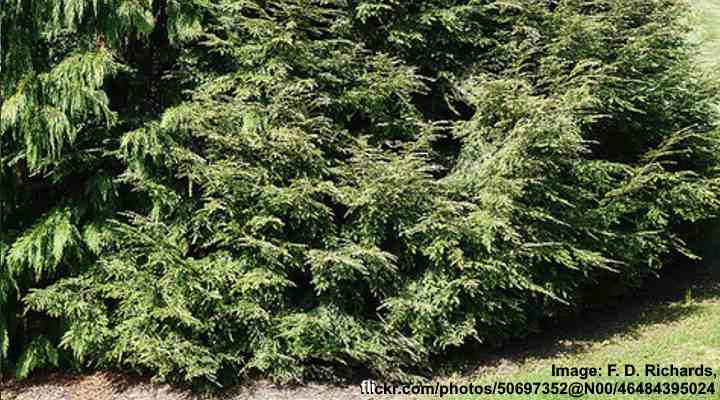
Tsuga canadensis ‘Gentsch White’
The stunning dwarf hemlock ‘Gentsch White’ is a variegated Canadian hemlock cultivar featuring sprays of green foliage that has silvery-white tips. The mounding hemlock shrub grows 3 to 4 ft. (1 – 1.2 m) tall and wide. The ornamental evergreen shrub looks like it’s covered in snow.
Canadian Hemlock ‘Aurea Compacta’ (Tsuga canadensis ‘Aurea Compacta’)

Tsuga canadensis ‘Aurea Compacta’ (‘Everitt’s Golden’)
Also known as ‘Everitt’s Golden,’ this dwarf decorative hemlock has golden-yellowish green needle leaves and an upright growth habit. Maturing at 5 ft. (1.5 m) tall and 3 ft. (1 m) wide, this compact hemlock is ideal for small gardens where space is limited.
Canadian Hemlock ‘Cole’s Prostrate’ (Tsuga canadensis ‘Cole’s Prostrate’)

Tsuga canadensis ‘Cole’s Prostrate’
The ‘Cole’s Prostrate’ hemlock cultivar is a low-growing evergreen shrub that is suitable for evergreen ground cover in the shade. It’s a slow-growing needled plant that grows 12” (30 cm) tall and up to 5 ft. (1.5 m) wide.
Western Hemlock (Tsuga heterophylla)
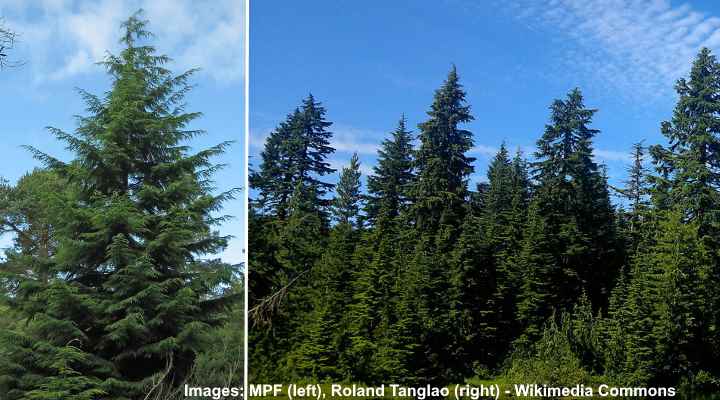
Western hemlock (Tsuga heterophylla) trees
The Western hemlock (Tsuga heterophylla) is a large conifer in the pine family that grows between 165 and 230 ft. (50 – 70 m) tall. The Western hemlock is distinguished by its flattened needle leaves, 0.9” (2.3 cm) long cylindrical cones, and broadly pyramidal crown. Like the Eastern hemlock, the Western species has a drooping growth habit at the tips.
Western hemlocks, like the Eastern hemlock species, are cold hardy to USDA zone 3. The hemlock trees grow all along the Pacific coast and in the Rocky Mountains. For this reason, Tsuga heterophylla also goes by the name Pacific hemlock.
Western Hemlock Bark

Bark of a mature Western hemlock tree
Western hemlock bark is smooth and reddish-brown on younger trees. As the hemlock ages, the bark becomes dark gray-brown and develops vertical fissures with a scaly appearance.
Western Hemlock Cones

Western hemlock cones and leaves
Western hemlock cones emerge green and mature to a grayish-brown color. The cylindrical hemlock “fruits” grow up to 1.1” (3 cm) long and 0.3” (0.8 cm) wide. Like the Eastern hemlock, the egg-shaped cones grow profusely, dangling from the reddish-brown branches.
Western Hemlock Needles
Western hemlock needle-like leaves are dark, glossy green, and longer than Eastern hemlock needles. The oblong hemlock needles with rounded tips measure 0.9” (2.3 cm) long and 2 millimeters wide. An identifying feature of hemlock leaves is the two white bands on the undersides.
Western Hemlock Identification
Western hemlock is an enormous evergreen tree with sprays of feathery, dark green needle foliage, pendulous small woody cones, and branches with drooping tips. To help identify Western hemlocks, look for flat needles of varying lengths attached individually to branches in a twisting arrangement. There are distinctive white stripes on the leaf undersides.
Carolina Hemlock (Tsuga caroliniana)

Carolina hemlock (Tsuga caroliniana) trees
Carolina hemlock is native to the Appalachian Mountains and can be found in Virginia, North Carolina, Georgia, South Carolina and Tennessee. It grows in moist soils that are well-drained, and requires regular watering, especially in dry conditions.
Carolina hemlock is used as an ornamental tree and can be grown in partial to full shade areas of your landscaped garden. It has a pyramidal shape, similar in appearance to eastern hemlock, with slightly pendulous branches, and can grow up to 100 ft. (30 m) tall with 20 – 25 ft. (6 – 7.6 m) spread.
Carolina hemlock bark is reddish-brown, and becomes furrowed, thick and develops ridges as the tree matures.

Carolina hemlock bark
Carolina hemlock needles are small glossy dark green and flattened, up to 3/4″ (1.9 cm) long, with two white stripes underneath.

Carolina hemlock leaves
Carolina hemlock cones are green when immature, measure 1.5″ (3.8 cm) long and become brown when mature.
Mountain Hemlock (Tsuga mertensiana)

Mountain hemlock (Tsuga mertensiana) trees
Mountain hemlock (Tsuga mertensiana) is a medium-sized conifer with flattened needle-like bluish-green leaves arranged spirally on the shoots. Mountain hemlocks grow between 66 and 130 ft. (20 – 40 m) tall and up to 42 ft. (13 m) wide. Mountain hemlock trees grow in the same range as Western hemlocks.
One of the distinguishing features of the mountain hemlock is its long, cylindrical cones. Most hemlocks have short, stumpy cones. However, the mountain hemlock cones grow up to 3” (8 cm) long and 1” (3 cm) wide.
Mountain hemlock bark is thin and a grayish to reddish-brown color. As the hemlock matures, the bark thickens and becomes scaly with deep fissuring.
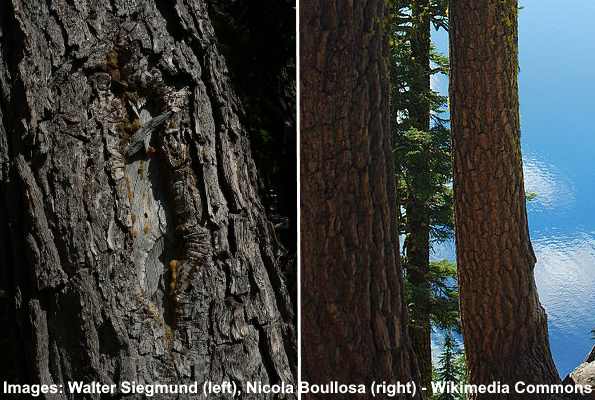
Mountain hemlock bark of mature trees
Mountain hemlock cones emerge purple and look more like spruce tree cones than hemlock cones. The pendulous cylindrical cones turn red-brown as they mature. Mountain hemlock cones are 1” to 3” (2.5 – 8 cm) long.

Mountain hemlock cones and leaves
Mountain hemlock needles are flattened like all hemlock species; however, they are more rounded than the Eastern or Western varieties. The needle-like leaves are 1” (2.5 cm) long with blunt tips. Mountain hemlock leaves are identified by their blue-green upper sides and silvery-white undersides.
Himalayan Hemlock (Tsuga dumosa)

Himalayan hemlock (Tsuga dumosa) trees
Himalayan hemlock trees (Tsuga dumosa) are tall conifers that grow between 65 and 80 ft. (20 – 25 m) tall. Features of the Himalayan hemlock are linear-shaped, glossy green needle leaves, round globule cones, and grayish-brown fissured bark. The Himalayan hemlock tree is identified by its broad, irregular conical crown.

Himalayan hemlock needles and bark
Like all hemlocks, the Himalayan hemlock has flattened needle-like leaves. The linear leaves have rounded tips and attach individually to branches by short stems. The hemlock leaves vary in length on branches, measuring between 0.5” and 1” (1 – 2.5 cm). The small egg-shaped seed cones are 1” (2.5 cm long)
Southern Japanese Hemlock (Tsuga sieboldii)
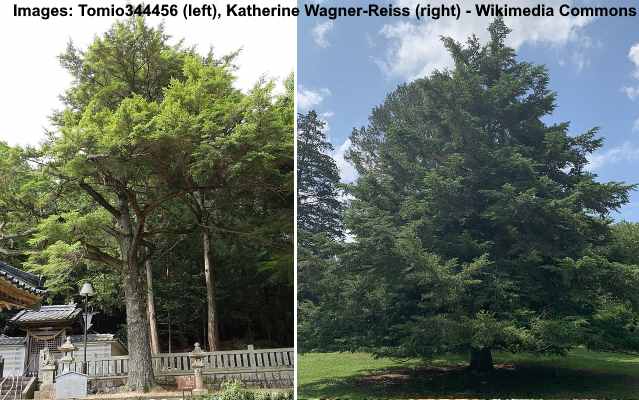
Southern Japanese hemlock (Tsuga sieboldii) trees
Southern Japanese hemlock trees are evergreen with a conical crown and dense needleleaf foliage. The hemlocks grow to around 50 ft. (15 m) in cultivation. The Asian hemlock is identified by short, flattened needles measuring between 0.3” and 0.5” (0.8 and 1.2 cm) with two white lines on the underside.

Tsuga sieboldii cones and leaves
Like all hemlocks, brown egg-shaped cones hanging from branches help identify this hemlock tree species. The bark of Southern Japanese hemlock is scaly dark grey to dark brown.
Related articles:
